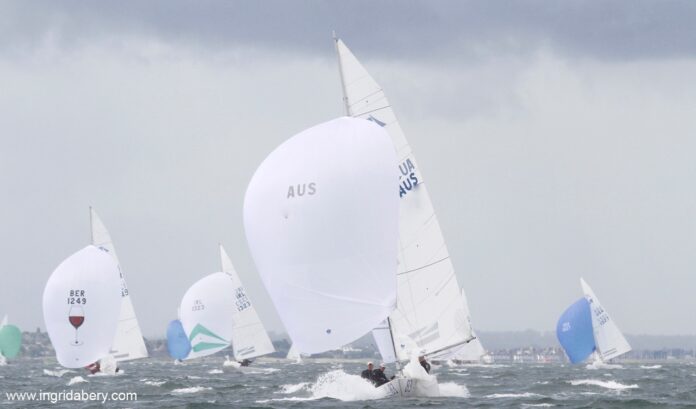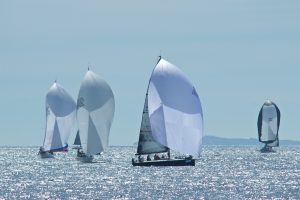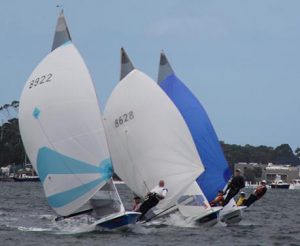

Sail away from shifts and toward better pressure.
Downwind Secrets – When you are racing upwind, the principal rule of thumb is to sail toward the next shift, on a run, however, you should sail away from the next shift because you are trying to make progress downwind, not upwind.
By getting farther away from the direction of the next shift you will end up on a lower ladder rung when that shift comes, and this means you will be closer to the leeward mark, one clear exception to this rule is when the next wind shift also brings an increase in wind velocity.
Your main priority should be finding the best pressure, once you take care of that, you can play the shifts.
Gaining ground to leeward
One common thing that happens on a reach or run is when the boat behind sails higher than you want to sail. This forces you to sail above the VMG course in order to keep your air clear in front of them. The problem is falling into their bad air and then losing ground to the rest of the fleet.
To avoid this happening try two things, first, as soon as the other boat starts heading high, luff up sharply in their path to let them know there is no way you will allow them to sail over you. The windward boat believes that they may be able to roll over you, so squash that early.
The second thing to try is talking to the other boat, and suggest they sail lower so that both of you can gain on the rest of the fleet.
If neither technique works and the other boat keeps sailing high, gybing is one way to keep your air clear and regain the ability to sail your VMG angle, but often this is not a strategic option.
The basic idea is to keep your wind (just) safely in front of the other boat, and at the same time try to work farther to leeward and away from them. In other words, pick a safe bearing to that boat and then try to hold this bearing constant while increasing your range (or distance) from them.

Sail your own race.
As they say, the best defence is usually a good offense. If you find the puffs, hit the shifts and sail your boat as fast as possible, there is little chance that boats will catch you from behind.
Sometimes the worst thing you can do is get overly defensive and reactionary; if you let the boats behind dictate how you sail down the run, you could easily miss the puffs and shifts and slowly lose your lead.
Instead, stay aggressive and proactive.
You want to minimise the amount of time that you sail in bad air, and you should generally stay between your opponent(s) and the leeward mark.
Avoid Laylines and Corners.
When you get to the sides of the course, you risk being cornered with no option to play wind shifts, cover the boats behind, or avoid wind shadows.
The only time when the layline is a good place for the leader is when the boat behind gets there first, then it’s easy to stay between that boat and the mark.
Improve your Exit Angles
One of the most important steering techniques for downwind boat speed is exiting gybes. Your exit angle affects your heel angle and acceleration.
During gybes, you should come out just a bit higher than your normal course and accelerate before steering to your downwind angle.
Constantly Ease the Kite
A good spinnaker trimmer is always easing the kite until they see a slight curl in the luff, and then trimming in slightly to eliminate the curl.
Once that process is complete, they do it over and over again to ensure that the spinnaker is not over-trimmed, which we all know is slow.
Experienced trimmers can even sense lifts and headers by constantly easing for a curl and watching the bow to see if the boat has turned.
If you ease more than normal before getting the curl, and the skipper sailed straight, you got lifted. If you get a big curl without easing, and without the skipper heading up, it’s a header.
Stating this aloud helps the helmsman immensely because he’s looking to gybe on lifts and sail straight on headers.
Sail fast on the longer Gybe.
When you come around the windward mark and you are almost fetching the leeward mark, the last thing you want to do is sail below your VMG angle or speed.
If the wind shifted left or increased in velocity, there was a fair chance you would fetch the mark on starboard gybe. If the wind went right, you could gybe across the boats that sailed lower.
In either case, you would gain the most by sailing fast down the run without worrying about fetching the mark until you were very close to it.

